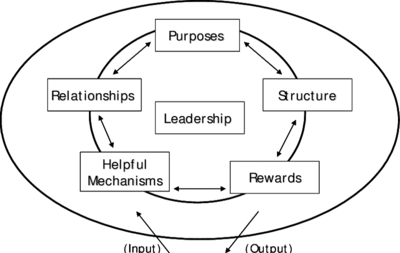Weisbord’s Six-Box Model
Weisbord’s Six-Box Model is a framework used to perform Organizational diagnosis. Weisbord (1976) proposes six broad categories in his model of organizational life, including purposes, structures, relationships, leadership, rewards, and helpful mechanisms. The purposes of an organization are the organization’s mission and goals. Weisbord refers to structure as the way in which the organization is organized; this may be by function – where specialists work together – or by product, program, or project – where multi-skilled teams work together. The ways in which people and units interact is termed relationships. Also included in the box of relationships is the way in which people interact with technology in their work. Rewards are the intrinsic and extrinsic rewards people associate with their work. The leadership box refers to typical leadership tasks, including the balance between the other boxes. Finally, the helping mechanisms are the planning, controlling, budgeting, and information systems that serve to meet organizational goals. The external environment is also depicted in Weisbord’s model, although it is not represented as a “box” (see figure below),

source: Nisha Nair Neharika Vohra
Weisbord identifies as inputs the money, people, ideas, and machinery which are used to fulfill the organization’s mission. The outputs are products and services. Two premises which are not apparent in Weisbord’s model are crucial to understanding the boxes in the model. The first premise refers to formal versus informal systems. Formal systems are those policies and procedures the organization claims to do. In contrast, informal systems are those behaviors which actually occur. The bigger the gap between the formal and informal systems, the less effective the organization is consider to be. The second premise concerns the fit between the organization and the environment, that is, the discrepancy between the existing organization and the way the organization should function to meet external demands. Weisbord defines external demands or pressures as customers, government, and unions. Weisbord poses diagnostic questions for each box of his model. For example, he suggests that OD consultants determine whether organizational members agree with and support the organization’s mission and goals within the purposes box. This question refers to his premise regarding the nature of the formal and informal systems within the organization.[1]
